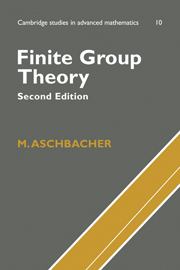Book contents
- Frontmatter
- Contents
- Preface
- 1 Preliminary results
- 2 Permutation representations
- 3 Representations of groups on groups
- 4 Linear representations
- 5 Permutation groups
- 6 Extensions of groups and modules
- 7 Spaces with forms
- 8 p-groups
- 9 Change of field of a linear representation
- 10 Presentations of groups
- 11 The generalized Fitting subgroup
- 12 Linear representations of finite groups
- 13 Transfer and fusion
- 14 The geometry of groups of Lie type
- 15 Signalizer functors
- 16 Finite simple groups
- Appendix
- References
- List of Symbols
- Index
3 - Representations of groups on groups
Published online by Cambridge University Press: 05 June 2012
- Frontmatter
- Contents
- Preface
- 1 Preliminary results
- 2 Permutation representations
- 3 Representations of groups on groups
- 4 Linear representations
- 5 Permutation groups
- 6 Extensions of groups and modules
- 7 Spaces with forms
- 8 p-groups
- 9 Change of field of a linear representation
- 10 Presentations of groups
- 11 The generalized Fitting subgroup
- 12 Linear representations of finite groups
- 13 Transfer and fusion
- 14 The geometry of groups of Lie type
- 15 Signalizer functors
- 16 Finite simple groups
- Appendix
- References
- List of Symbols
- Index
Summary
Chapter 3 investigates representations in the category of groups and homomorphisms, with emphasis on the normal and subnormal subgroups of groups.
In section 7 the concept of an irreducible representation is defined, and the Jordan–Hölder Theorem is established. As a consequence, the composition factors of a finite group are seen to be an invariant of the group, and these composition factors are simple.
The question arises as to how much the structure of a group is controlled by its composition factors. Certainly many nonisomorphic groups can have the same set of composition factors, so control is far from complete. To investigate this question further we must consider extensions of a group G by a group A. Section 10 studies split extensions and introduces semidirect products. Section 9 investigates solvable and nilpotent groups. For finite groups this amounts to the study of groups all of whose composition factors are, in the first case, of prime order and, in the second, of order p for some fixed prime p.
Commutators, characteristic subgroups, minimal normal subgroups, central products, and wreath products are also studied.
Normal series
In this section G and A are groups, and π: A → Aut(G) is a representation of A in the category of groups and homomorphisms. I'll also say that A acts as a group of automorphisms on G. Observe that π is also a permutation representation, so we can use the terminology, notation, and results from chapter 2.
- Type
- Chapter
- Information
- Finite Group Theory , pp. 22 - 34Publisher: Cambridge University PressPrint publication year: 2000

